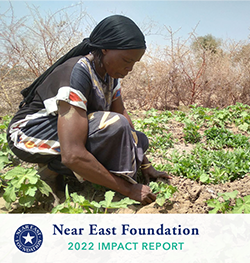by Alinta Geling
Over the years, the depletion of natural resources in Mali has become a major focus of the international community and also for the Near East Foundation. Depletion of natural resources can not only result in the loss of ecosystems but it can also be a source of social unrest and conflict.
In partnership with local communities and the Malian government, NEF is taking the necessary steps to help sustain Mali’s natural resources and avert future conflicts.
In the Bandiagra region of Mali, thousands of people depend on the Touperè Forest. These people noticed that their forest was getting more and more depleted and the number of plants and animals were slowly diminishing. Something had to be done, so they asked for help.
In response to their call to action, NEF brought all the 22 villages surrounding the forest together in a three-day conference to formulate a convention on the management of the forest.
On the first day of the convention, more than 100 people – young, old, women, men, and children – came to find a workable solution to the issue. Every village sent four representatives: their chief, a youth representative, a representative of the women, and a representative of the farmers.
Even though all the villagers come from the same region, they do not speak the same language (of the 7,000 languages spoken in the world, almost 1/3 are spoken in Africa). To ensure that everyone was able to participate in the conference, everything was translated to French, Bambara, Dogon and Peul.
Together with the representatives of the state and of the local government, this diverse collection of people represented the traditional beneficiaries of the forest and its resources.
The conference started by drawing a huge map of the forest and its surroundings. The participants located their village, existing resources, the main roads, and other important landmarks. With this in hand, they identified major stakeholders of the forest: who uses the forest, what they use, what is exported, what is imported, who decides how much is needed, etc.
It turns out all the villages have different rules and traditions in using the forest’s resources. By articulating their needs, people from different villages learned from each other and came to understand their differences.
Over the three days, they started formulating the problems they experience: diminishing numbers of animals and plants, the lack of water, poaching, deforestation, conflicts between farmers and pastoralists. Everything was written down, discussed, and reformulated. After reviewing the problems, the possible solutions were discussed. What can be done? What is realistic? What are the priorities?
While NEF played an integral role in bringing the villages together and facilitating the discussion, the villagers themselves take the lead in formulating solutions and decision-making.
“In the end it is not NEF that benefits from the forest, and it is not NEF that will implement the convention,” said Alkaïdi Touré, the NEF facilitator. “It is their forest, it is their problems, the whole process depends on their participation and input.”
Three days, 300 liters of water, and 700 cups of Malian Tea later, a first draft of the convention is finished. The result of these three days is written on large spreadsheet: six key problems were identified and possible solutions proposed. Now, it is up to the participants to go home and discuss the results with the rest of their village. Soon they will all return with feedback from their village to continue to discuss their problems and solutions in this formal convention, which will then be legalized by the Malian state. Stay tuned!


